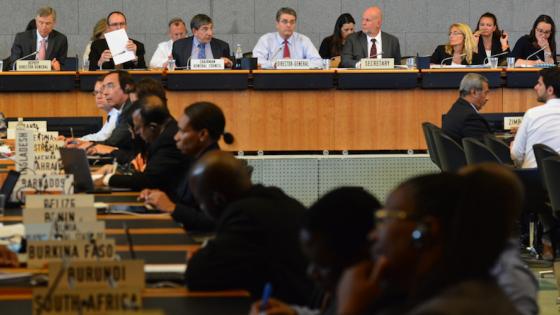Since 1947, the General Agreement on Tariffs and Trade (GATT) and its successor organisation, the WTO, have served as the multilateral forum where governments meet to agree on the rules of international trade policy. The objectives of the member governments in creating GATT are laid out in the GATT Preamble and include “raising standards of living” and ensuring a “large and steadily growing volume of real income and effective demand”. The Preamble also expresses the governments’ belief that “reciprocal and mutually advantageous arrangements directed to the substantial reduction of tariffs and other barriers to trade and to the elimination of discriminatory treatment in international commerce” would contribute to these objectives.
The most-favoured nation rule
The most important representation of non-discriminatory treatment in the GATT/WTO is found in the most-favoured nation (MFN) rule, under which a country must impose the same tariff on a given imported product regardless of the exporter source of that product.1 At a broad level, and as has long been recognised, the MFN rule has potential advantages and disadvantages.2 A benefit of the rule is that it eliminates the trade-diversion distortions that accompany discriminatory tariffs. A more subtle issue, however, concerns the implications of the MFN rule for governments’ ability to negotiate mutually advantageous and substantial reductions in tariffs. A potential concern in this regard is that the MFN rule could generate third-party benefits that diminish the magnitude of negotiated tariff reductions.
Previous research by Ossa (2014) has examined the welfare losses from a hypothetical trade war using modern quantitative trade modelling.3 Using the same class of models, our research examines a market design question about negotiations at GATT/WTO (Bagwell et al. 2018). Specifically, we study the impacts of the MFN rule, and ask whether MFN hinders or hurts the outcomes of negotiations at GATT/WTO. To accomplish this, we combine trade data from 1990 with before-and-after tariff data from the Uruguay Round, the last successfully completed negotiation round of the GATT. The Uruguay Round was concluded in 1994 and resulted in the creation of the WTO in 1995. According to the WTO web site, the Uruguay Round “was quite simply the largest trade negotiation ever, and most probably the largest negotiation of any kind in history” (WTO 2018).
Tariff bargaining in the GATT/WTO
Tariff liberalisation at the GATT/WTO occurs during negotiating rounds. Since WWII, there have been nine negotiating rounds, with the Uruguay Round being the last successfully completed round. During most negotiating rounds, including the Uruguay Round, countries negotiated bilaterally and item-by-item. For example, the US and the EU would exchange concessions on products relevant to them, while the US and Japan would also exchange concessions in a separate negotiation. Bagwell et al.(2017a) provides details on the negotiating procedure using offer and counter-offer data from an early round. Any exchange of concessions agreed upon bilaterally during the round would then be multilateralised via MFN. As an example, if the US and EU negotiation arrived at an agreement whereby the US would lower tariffs on cars to 5% and the EU would lower tariffs on computers to 3%, then all other WTO members would face a 5% tariff on cars into the US and a 3% tariff on computers into the EU. Similarly, the US and EU would face whatever tariffs were agreed upon in other bilateral negotiations. The final product of a typical WTO round is thus a set of concessions agreed upon by many bilateral negotiations, but applying to all members of the WTO going forward. Thus, a WTO round is a nexus of interconnected bilateral negotiations governed by the MFN rule.
MFN and tariff bargaining
Theoretical research has considered the implications of the MFN rule for tariff bargaining outcomes (see Bagwell et al. 2016 for a survey). At a high level, the MFN rule changes the nature of external effects of one bilateral negotiation on other countries. With MFN, the external effects of concessions are positive for third-party countries that export the relevant goods – such countries benefit from negotiated concessions as these reductions in tariffs also apply to their exports. Absent MFN, bilateral reductions in tariffs are discriminatory in that the third-party countries then face higher relative tariffs than does the country that negotiated the concession. The external effects are negative in this case, since demand for third-party countries’ exports into the negotiating countries decreases. When external effects are positive, a natural conjecture is that equilibrium bilateral agreements will not liberalise sufficiently. Since the negotiating parties do not internalise the positive external effects, they will not go far enough. Conversely, when external effects are negative, one worries that equilibrium bilateral agreements will go too far. The negotiating countries opportunistically benefit from tariff reductions at the expense of third parties. Bagwell et al. (2017b) formalise and qualify these intuitions in a pared-down model of trade and bargaining. Which type of external effects leads to overall better outcomes is unclear theoretically and likely depends on specific patterns of technology and trade. We turn to the data to help address this question.
Results from a quantitative trade model
Since we have not observed WTO negotiation with and without the MFN rule, we use a model-based empirical approach. Specifically, we specify a quantitative trade system (following Eaton and Kortum 2002, Costinot et al. 2011), and embed the trade system into a model of bilateral bargaining with externalities (Horn and Wolinsky 1988) while imposing the MFN constraint on negotiations. These bargaining models have seen increased usage in the industrial organisation literature for modelling bilateral oligopoly (e.g. Crawford and Yurukoglu 2012). We then search for parameters of the model to match observed trade patterns by sector-origin-destination, relative value-added levels across countries, and observed tariff concessions from the Uruguay Round of negotiations. Using these estimated parameters, we simulate, within the context of the model, the removal of MFN.
Our simulations indicate that, in the context of the model, the MFN rule during the Uruguay Round of negotiations led to better bargaining outcomes than would have obtained in the absence of this rule. We verify that the estimated model produces the expected direction of externalities in negotiations. With MFN, third parties benefit from non-discriminatory bilateral concessions, and absent MFN, third parties are hurt by discriminatory bilateral concessions. Interestingly, the overall level of tariff reductions in the two regimes is similar. But the degree to which countries are incentivised to negotiate deeper tariff cuts when those cuts can be discriminatory shows up clearly when the ‘no-MFN’ averages are calculated over only the product-and-country pairs that were also in play under MFN. Under this calculation, the average tariff under negotiation when MFN is abandoned drops by 107.35% as compared to a drop of 46.95% when MFN is in place. The upshot is that the equilibrium absent MFN exhibits a wide range of discriminatory tariffs, including significant negative tariffs. Pairs of countries sometimes face an incentive to subsidise each other’s exports, thereby driving up wages at home to the benefit of their workers. Negotiations with MFN lead to an increase in total welfare that is about 70% of the model’s predicted total welfare increase under free trade. While tariffs fall from these levels on average in the negotiations absent MFN, the pattern of tariffs is so distorted that, from a total (world) welfare point of view, the equilibrium is worse when MFN is abandoned and hardly better than if there had been no negotiation at all.
Open questions
Several open questions remain. The analysis takes as fixed the set of regional free trade agreements in place. Modelling the co-evolution of regional free trade agreements and tariff liberalisation at the WTO might have important implications for the market design of WTO negotiations. Improvements to the realism of the quantitative model of trade to allow for productivity changes, imperfect competition, and rich demand systems would also be welcome. Our analysis also mostly abstracts from non-tariff considerations that were under negotiation in the Uruguay Round. We also abstract from political-economy forces and from a reciprocity norm in negotiation. With these caveats in mind, our analysis points to an efficiency-enhancing role for the MFN rule in the Uruguay Round.
References
Bagwell, K, C P Bown, and R W Staiger (2016), “Is the WTO Passe?”, Journal of Economic Literature 54(4): 1-107.
Bagwell, K, R W Staiger, and A Yurukoglu (2017a), “Multilateral trade bargaining: A first look at the GATT bargaining records”, NBER working paper 21488.
Bagwell, K, R W Staiger, and A Yurukoglu (2017b), “’Nash-in-Nash’ Tariff bargaining with and without MFN”, NBER working paper 23894.
Bagwell, K, R W Staiger, and A Yurukoglu (2018), “Quantitative Analysis of Multi-Party Tariff Negotiations”, NBER working paper 24273.
Costinot, A, D Donaldson, and I Komunjer (2011), “What goods do countries trade? A quantitative exploration of Ricardo's ideas”, The Review of Economic Studies 79(2): 581-608.
Crawford, G S, and A Yurukoglu (2012), “The welfare effects of bundling in multichannel television markets”, American Economic Review 102(2): 643-685.
Eaton, J, and S Kortum (2002), “Technology, geography, and trade”, Econometrica 70(5): 1741-1779.
Hawkins, H C (1951), Commercial Treaties & Agreements: Principles & Practice, Rinehart & Company, Inc.
Horn, H, and A Wolinsky (1988), “Bilateral monopolies and incentives for merger”, The RAND Journal of Economics, 408-419.
Nicita, A, M Olarreaga, and P Silva (2018a), “Cooperation in WTO’s tariff waters?”, Journal of Political Economy, forthcoming.
Nicita, A, M Olarreaga, and P Silva (2018b), “A trade war will increase average tariffs by 32 percentage points”, VoxEU.org.
Ossa, R (2014), “Trade wars and trade talks with data”, American Economic Review 104 (12): 4104-46.
Viner, J (1924), “The Most-Favored-Nation Clause in American Commercial Treaties”, Journal of Political Economy 32(1): 101-129.
WTO (2018), “The Uruguay Round”.
Endnotes
[1] The MFN rule has important exceptions in GATT/WTO, including an exception for preferential trade agreements, but it is nevertheless a foundational pillar of the GATT/WTO architecture.
[2] For early discussions of tariff bargaining and the MFN rule, see, e.g., Viner (1924) and Hawkins (1951).
[3] Ossa (2014) examines the welfare losses from a hypothetical trade war among six of the world’s largest trading partners. Nicita et al.(2018a) estimate the foreign export supply elasticities at the tariff line level faced by all WTO members, and as discussed in Nicita et al.(2018), use these estimates to calculate the welfare losses from a hypothetical world-wide trade war.






